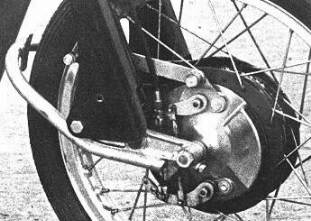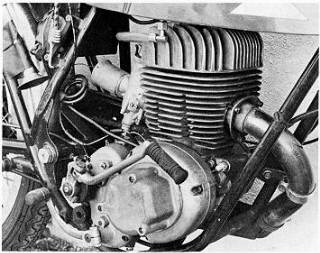The 247cc Cotton Conquest 1965
BY a cool six mph, the Cotton "Conquest'' which Derek
Minter and Peter Inchley took to a class victory in the 1965 500-mile race
at Castle Combe, becomes the fastest 250 we have ever tested. It averaged
91.9 mph round the 3-mile banked circuit of MIRA'S proving ground. Previous
best was the 86.0 mph of the Honda "Dream SS': However, this "Conquest''
is a road-going racer, with questionable silencing and primitive lights,
just conforming to Road Traffic Act requirements and production-machine-
racing regulations.
High compression
Torque characteristics
Megaphonitis
(Top right) The tacho drive is taken direct from the Starmaker
Crankshaft. Cable into top of chaincase controls the diaphragm clutch.
(Top Left) The 7 inch brake on the British Hub wheel has 2 leading shoes
and a parallelogram reaction linkage. (Bottom left) Crank in the folding
kickstart is to clear the reversed gear pedal which has up-for-up action.
( Bottom right) Distinctive finning of the later type Starmaker whose central
exhaust port imposes severe frame constraints.
Engine:
Frame:
Tank:
" ... the bike featured is owned by one of my brothers in England and
he has been restoring it.
HTML conversion
courtesy
Chris Dupen
of Netbikes
Copyright
Bruce
Main-smith
It is basically a standard "Conquest'' as turned out
by the Gloucester factory, but with the compression ratio increased from
10 : 1 to 12 : 1. The test "Conquest'' had bobby-dodger items such as feeble,
direct lighting in place of the standard Lucas diode lighting and a bulb
horn. Shod with racing tyres, it lacked centre or prop stands. It cannot
be put into the same class as the fully equipped and well silenced 250
Honda. In fact, the Minter/lnchley "Conquest'' is in a class of its own.
Orders for exact replicas have already been placed a provisional price
of £370 including Purchase Tax.
Tuned to give rising torque all the way, the Villiers
"Starmaker'' two-stroke single always reached maximum revs on any up-gradient
which it was able to climb in top gear, This gave it a shattering motorway
performance, leaving behind on the hills much faster cars capable of cruising
at 14% mph and more on level roads. The Cotton climbed such hills at 85
to 90mph. It was cruised at full bore by the simple expedient of putting
the throttle against the stop and leaving it there from London to the Midlands
and returns except past motorway roadworks, This is a race engine, designed
to be run at maximum effort, and it thrives on it. On downgrades the speedometer
rose to flicker around the 114 to 116 mph mark, if the rider got his head
down. This, after speedometer correction, would suggest a true 105. Owing
to the engine's unusual characteristic of rising torque up to peak rpm
of 8000, the machine was faster on a windswept timing lap at MIRA than
it was through the one-way timing traps, the first time we have ever experienced
this. This feature makes the engine rush up the power band once about 5400
had been reached. The acceleration was then staggeringly good.
Below this speed, and especially under 3500 rpm when
bad four-stroking set in, the rate of rev rise, even in a low gear, was
poor calling for much use of the gearbox to effect a cure. Flywheel weight
was negligible. This, the lack of low-down urge, the exhaust note, made
traffic riding grim. The Cotton needed a softer plug in London - and changing
a plug meant some five minutes fiddling under the tank. By no stretch of
the imagination can the Minter/ Inchley device be regarded as daily transport.
It is in its element on the open road - and only on the open road. The
motor was then untirable, free from vibration, and no thirstier than about
45 mpg. The fuel tank holds five gallons which is mixed with an R oil at
16 : 1.





Villiers 247 cc Starmaker single- cylinder two .stroke:
68 mm bore and stroke; light .alloy head and barrel; cr 12.0: 1 ; Amal
1 3/8(?) Monobloc; expansion -contraction chamber exhaust system
; makers claimed output 30 bhp @7500rpm
Electrical Equipment:
Villiers energy-transfer- flywheel magneto
with direct lighting from alternator coils.
Transmission:
Villiers bolted-on four-speed box, Overall ratios of
5.6, 6.7, 8.0, 12.3: 1 Two-plate sintered-bronze diaphragm-spring clutch.
Duplex front-down-tube double- tank-fail type with duplex
seat pillars and integral ''rear sub-frame ''
Suspension:
Armstrong short-leading-link forks.
Rear swinging-fork. Movement front and rear controlled
by Girling units with coil springs and two-way hydraulic damping,
Wheels:
19in light-alloy rims carrying Dunlop racing tyres, 2.75
in at front and 3.25 in at rear; two-leading-shoe 7 x 1&3/8in ventilated
front and single-ls 6 x 1&1/8in rear British Hub brakes.
Mitchenall 5 ga1 glass fibre racing tank with quick action
filler, breather tube, knee recesses and twin taps,
Weight:
230lb dry (makers figure) ,
General Equipment:
Mitchenall seat cone & rear guard; Smiths 125mph
speedometer; Smiths 10,000rpm rev counter; bulb horn & registration
plates.
Price: standard machine: £279
12s. (inc £46 12s P.T.); Exact replica:
approximately £90 extra.
Makers:
E.Cotton (Motorcycles) Ltd, Vulcan Works, Quay Street,
Gloucester.
Dave Ball, NZ." (Email Feb 2000)
Roadtests
Republished Volume 3.
Site by ManxNorton.com 